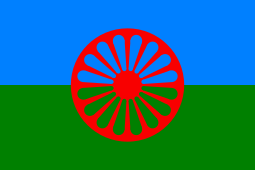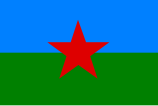Roma flag

| |
| Name | O styago le romengo |
|---|---|
| Use | Ethnic flag |
| Adopted | 1971 |
| Designed by |
World Romani Congress Weer Rajendra Rishi |
 Variant flag of Flag of the Romani people
| |
| Use | Ethnic flag |
The Romani flag or flag of the Roma (Romani: O styago le romengo) is the international flag of the Romani people. It was approved by the representatives of various Romani communities the first World Romani Congress (WRC), held in Orpington in 1971. The flag consists of a background of blue and green, representing the heavens and earth, respectively; it also contains a 16-spoke red chakra, or cartwheel, in the center. The latter element stands for the itinerant tradition of the Romani people and is also an homage to the flag of India, added to the flag by scholar Weer Rajendra Rishi. This design was especially popular in Socialist Yugoslavia, which awarded it official recognition upon adoption.
The first of several ancestors for the WRC flag is a bicolor reportedly flown by the Romanian Romanies during the 1930s, and revived internationally during the 1960s. A tricolor version, flown by survivors of the Romani genocide, fell out of use do to allegations that it stood for communism. The definitive variant designed in 1971 gained in popularity over the subsequent decades, being especially associated with groups promoting transnational unity of the people and combating its designation as "Gypsies". The flag was promoted by actor Yul Brynner and violinist Yehudi Menuhin, and also adopted by Florin Cioabă, self-proclaimed "King of the Roma".
Several countries and communities have recognized it officially during the 2010s, but its display has also sparked controversy in various parts of the European Union. Derivatives also became widely used in Romani political symbolism during the same period. However, inside the scholarly community, the Romani flag has been criticized as Eurocentric, and its display as a perfunctory solution to issues facing the ethnic group it represents.
...
Wikipedia
